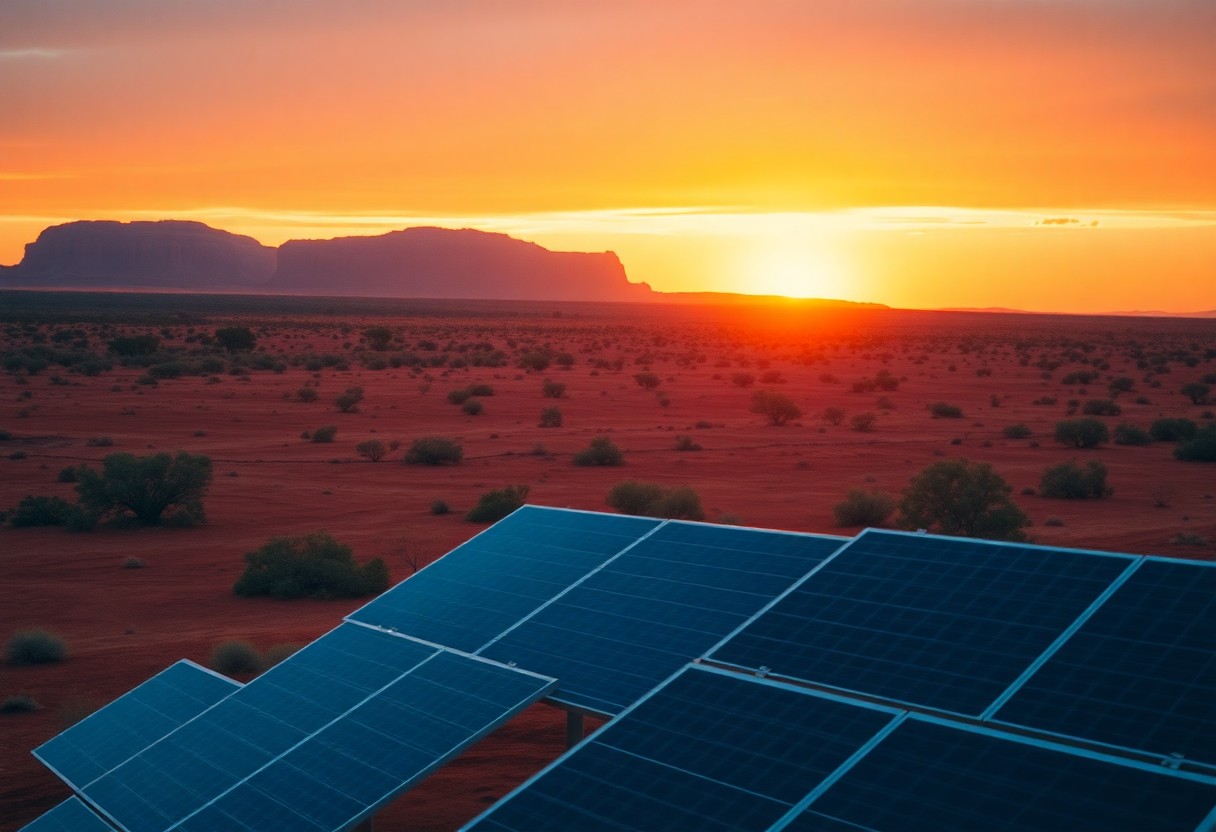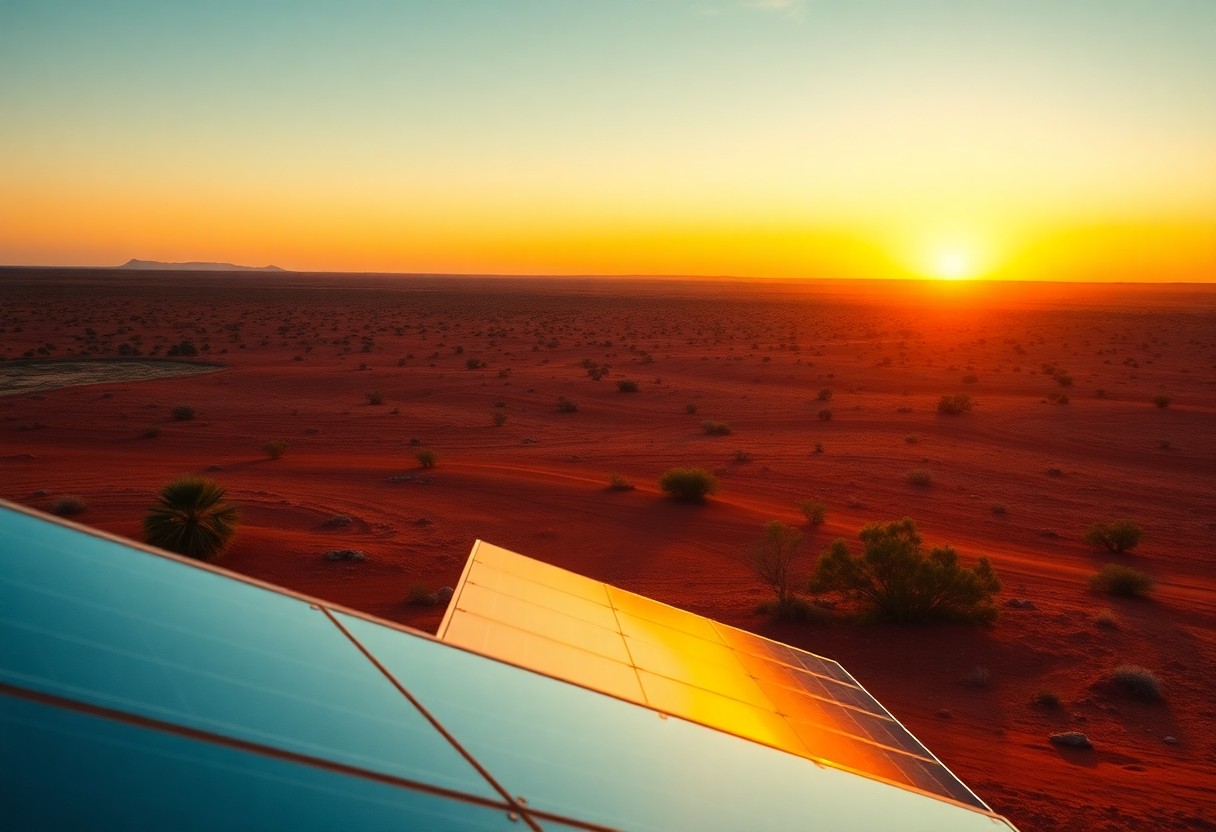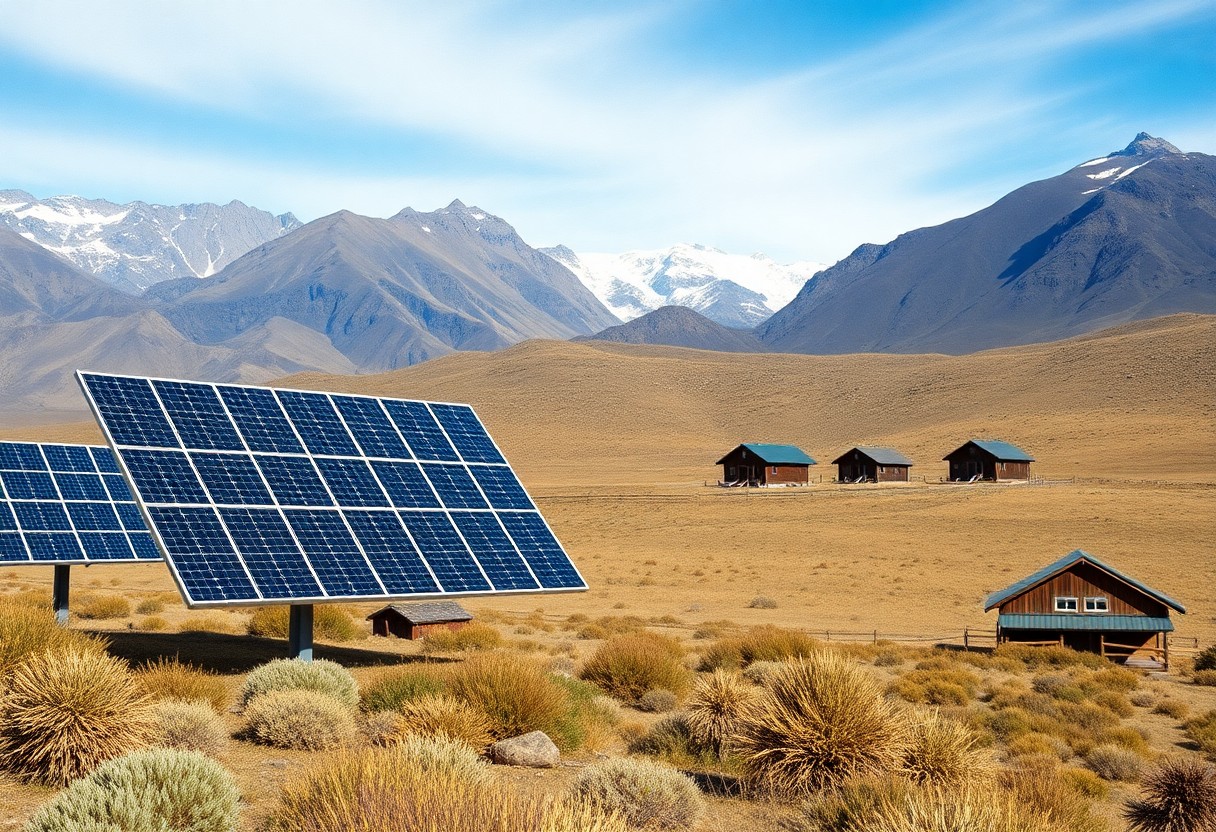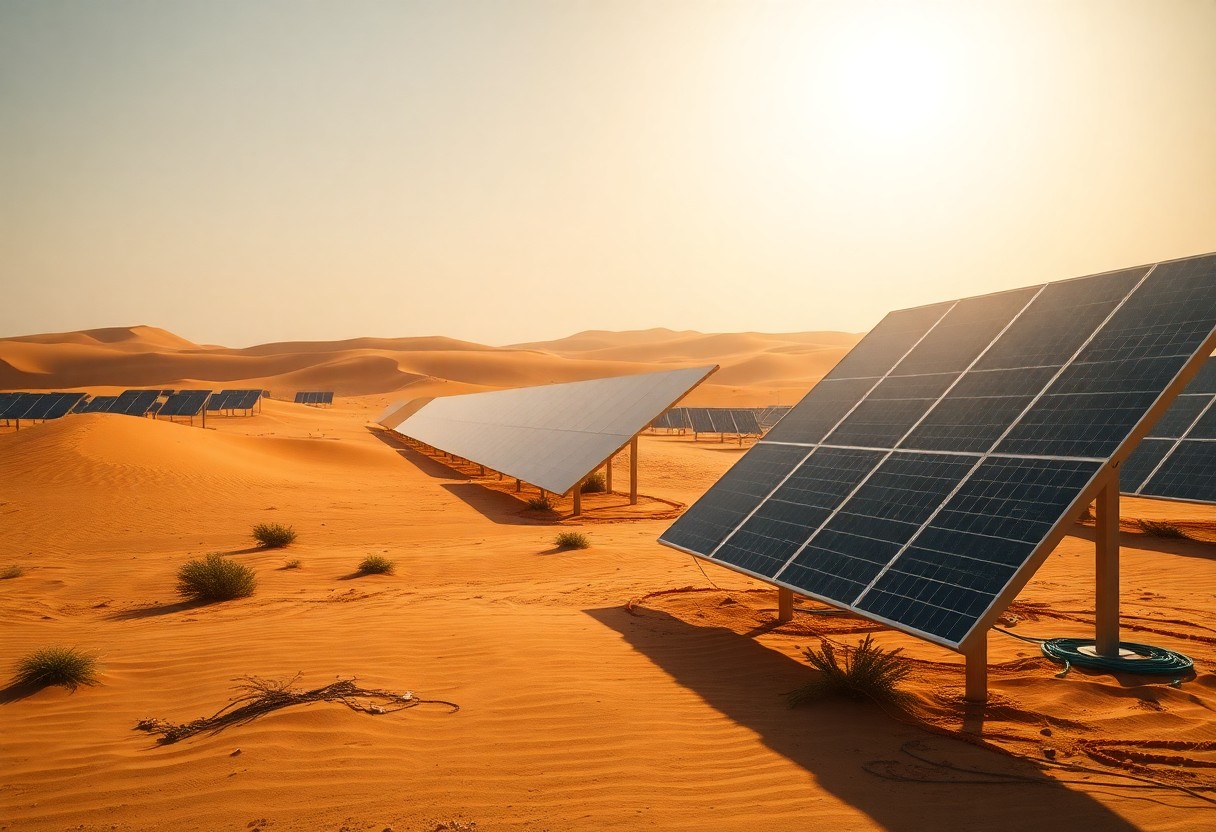Over the vast, sun-drenched landscape of the Australian Outback, you’ll find a unique opportunity for harnessing renewable energy. With its abundant sunlight, minimal population density, and extensive available land, the Outback presents an ideal setting for solar power generation. The region’s extreme weather conditions might pose challenges, but the potential for sustainable energy solutions is undeniable. By embracing solar power, you not only contribute to reducing carbon footprints but also help drive economic growth in remote areas.
Key Takeaways:
- The Australian Outback receives high levels of solar radiation year-round, making it an ideal location for solar energy generation.
- Extensive land availability in remote regions allows for large-scale solar farms, minimizing land use conflicts while maximizing energy output.
- Advancements in solar technology and storage solutions increase the feasibility of harnessing solar power in the Outback, contributing to a sustainable energy future.

Geographic Advantages
While the Australian Outback may seem remote, its geographic advantages make it an ideal location for solar power generation. The region’s unique landscape and environmental conditions allow for optimal solar energy harvesting, providing you with opportunities to harness renewable energy effectively.
Abundant Sunshine
Abundant sunshine throughout the year is a significant advantage of the Australian Outback. With over 300 sunny days annually, you can maximize the efficiency of solar panels, ensuring a reliable and consistent energy supply. This high solar irradiance translates into lower electricity costs and a more sustainable energy future for you.
Vast Land Availability
Around the vast expanses of the Outback, land availability is practically limitless, offering plenty of room for solar farms. You can take advantage of these expansive areas to install solar infrastructure without the constraints typically found in urban environments.
It is notable that the open, flat terrain of the Outback allows for large-scale solar projects, making it easier for you to develop extensive solar farms. With minimal human interference and low population density, the risk of disruptions is reduced, providing a safer environment for solar installations. Additionally, the lower land costs compared to urban locations can result in significant savings for your solar investment, ultimately contributing to a more sustainable energy landscape in Australia.
Economic Considerations
You might be surprised to discover that the Australian Outback holds significant economic advantages when it comes to solar power. The vast, uninhabited areas provide ample space for solar farms, reducing land-use conflicts. Additionally, the high solar irradiance levels translate to more energy production, ultimately leading to lower energy costs for consumers and businesses alike.
Cost-Effectiveness of Solar Technology
The affordability of solar technology has improved dramatically in recent years, making it increasingly accessible for both individuals and businesses. As the cost of solar panels decreases and efficiency increases, investing in solar energy in the Australian Outback becomes more attractive financially.
Government Incentives and Support
To further promote solar adoption, the Australian government offers various incentives and support programs aimed at reducing financial barriers. These incentives can include tax rebates, grants, and low-interest loans that encourage both residential and commercial solar installations.
Incentives such as feed-in tariffs and rebates play a significant role in easing the financial burden of solar investments for you. By providing monetary returns for excess energy generated, you can effectively reduce your energy bills while contributing to a sustainable future. Additionally, low-interest loans help you finance solar installations with manageable repayments. These government initiatives not only lower the overall cost of solar technology but also promote a greener energy landscape in the Outback, making it easier for you to transition to renewable sources.
Environmental Impact
Not only does solar power offer sustainable energy solutions, but it also significantly reduces the overall environmental impact of energy production. By harnessing the abundant sunlight of the Australian Outback, you minimize reliance on fossil fuels, thus mitigating pollution and conserving precious natural resources. The shift to solar contributes to healthier air and water quality in your environment, making it a smart choice for both energy and ecological preservation.
Reduced Carbon Footprint
At the forefront of environmental benefits, solar energy helps you achieve a reduced carbon footprint. By transitioning to solar power, you can decrease greenhouse gas emissions, directly contributing to global efforts against climate change. This significant reduction not only aids in protecting the planet but also promotes a sustainable lifestyle for future generations.
Preservation of Local Ecosystems
The Australian Outback is home to a diverse array of ecosystems that can be positively impacted by the adoption of solar energy. By utilizing solar power, you help preserve local habitats and wildlife, minimizing disruption to the fragile ecosystems inherent to this region. Solar investments can also lead to more sustainable land management practices.
Considering the delicate balance within the Outback’s ecosystems, a switch to solar energy can foster biodiversity and encourage healthy wildlife populations. By generating energy from the sun, you reduce the development of environmentally damaging infrastructure, which often leads to habitat destruction. Moreover, the land can be used for dual purposes, allowing for agriculture and conservation alongside solar installations. This not only supports the local economy but also ensures that the Outback remains a thriving sanctuary for its unique flora and fauna.
Technological Innovations
Now, a range of technological innovations is rapidly transforming how solar energy is harnessed in the Australian Outback. From the development of more efficient solar panels to advanced battery storage solutions, these advancements are making solar power a more viable option than ever before. As you consider the potential of solar energy, it’s crucial to explore these cutting-edge technologies that are paving the way for a sustainable future.
Advancements in Solar Panel Efficiency
Technological advancements in solar panel efficiency have significantly increased energy capture, allowing you to generate more power from limited space. With improved designs and materials, modern solar panels can convert sunlight into electricity at rates previously thought impossible, making solar installations in the vast Outback both practical and efficient.
Battery Storage Solutions
An innovative approach to energy storage is revolutionizing how you can utilize solar power in remote areas. As battery technology advances, you can store excess energy generated during the sunny days for use during nighttime or cloudy conditions. This capability enhances your energy independence, making solar power a reliable choice in the Outback.
Indeed, the rise of battery storage solutions enhances the effectiveness of solar power, enabling you to maximize efficiency and grid independence. With cutting-edge options like lithium-ion and saltwater batteries, you can store substantial energy amounts without environmental concerns. These systems offer significant advantages, eliminating the need for constant grid access and providing you with a steady energy supply. Coupled with efficient solar panels, battery storage propels your energy strategy forward, ensuring that even in the Australian Outback, you enjoy the continuous benefits of solar power.
Infrastructure and Accessibility
Despite its remote nature, the Australian Outback has been steadily improving its infrastructure and accessibility. Investments in roads, telecommunications, and energy systems are vital for the establishment of solar power facilities. These advancements not only facilitate the transport of materials crucial for solar projects but also ensure that energy produced can be efficiently integrated into the national grid, making the Outback an increasingly appealing location for renewable energy investment.
Development of Solar Farms
Above all, the development of solar farms in the Outback is rapidly gaining traction, thanks to abundant sunlight and vast tracts of land. Solar projects are designed to harness this natural resource, contributing significantly to Australia’s renewable energy output. Your involvement in such projects can lead to substantial cost reductions and further spur advancements in solar technology.
Transportation and Delivery Challenges
Among the hurdles faced in solar energy development, transportation and delivery pose significant challenges for contractors and engineers. Accessing remote sites can be difficult due to harsh terrains and limited road infrastructure, making delivery of materials a complex task.
Transportation logistics can present several obstacles when developing solar farms in the Australian Outback. [Inaccessible roads] frequently delay shipments, which may hinder project timelines. Furthermore, the vast distances between suppliers and job sites can amplify shipping costs and lead to potential breakdowns during transportation. It is imperative that you consider these challenges when planning your solar initiatives, as effective logistics management will be key to ensuring project success and water-tight budgets.
Case Studies
Unlike many regions, the Australian Outback presents unique opportunities for solar power adoption. Here are notable case studies highlighting the benefits:
- Solar Over Boulia: 1 MW solar farm that delivers power to over 200 homes.
- Agnew Gold Mine: 20 MW solar project supplying nearly 50% of the mine’s energy needs.
- Solar Fortescue: 2,900 hectares dedicated to a 2 GW solar project, driving sustainability in mining operations.
- Clare Solar Farm: 100 MW capacity, powering around 30,000 homes annually by 2024.
Successful Solar Projects in the Outback
Before examining the potential of solar energy, look at successful projects making a significant impact in the Outback. These initiatives showcase solar power’s viability and sustainability, paving the way for more extensive adoption as technology continues to evolve.
Lessons Learned from Implementation
Along the journey of implementing solar projects, various lessons have emerged regarding resource management and community engagement. Engaging local stakeholders early ensures buy-in and smooth integration of solar solutions, addressing common concerns about land use and environmental impacts.
Another key insight is the importance of maintaining flexibility in project design, allowing for adaptation to unique regional challenges. Additionally, utilizing advanced storage systems can enhance energy reliability, especially in remote areas. You should consider ongoing monitoring and maintenance to optimize performance and address potential issues proactively. These insights can help you maximize the benefits of solar power while minimizing disruptions in the Outback environment.
Conclusion
With these considerations, you can see why the Australian Outback is an excellent candidate for solar power. The region’s abundant sunshine, vast open spaces, and low population density create an ideal setting for efficient solar energy production. By harnessing this renewable resource, you can contribute to sustainable energy solutions while benefiting from the technological advancements in solar infrastructure that continue to emerge. Embracing solar power in the Outback not only promotes environmental stewardship but also holds the potential for significant economic benefits in the long run.
Q: Why does the Australian Outback have high solar energy potential?
A: The Australian Outback enjoys abundant sunlight throughout the year, making it one of the sunniest regions in the world. With vast open spaces and minimal cloud cover, solar panels can operate at optimal efficiency. Additionally, the low population density means less competition for land use, allowing for large-scale solar farms to be established without significant disruption. Coupled with the country’s commitment to renewable energy and government incentives, this makes the Outback an exceptional candidate for solar energy development.
Q: What role do government policies play in enhancing solar power adoption in the Outback?
A: Government policies in Australia actively support renewable energy initiatives through various incentives, grants, and regulations. The Renewable Energy Target (RET) scheme encourages investment in solar power by providing financial benefits to those involved in renewable energy generation. This support is critical for fostering innovation, attracting investment, and ultimately increasing the deployment of solar technologies in the Outback. Furthermore, local governments often promote sustainability initiatives that prioritize solar energy systems, enhancing their viability in rural and remote areas.
Q: What are the economic benefits of developing solar power in the Australian Outback?
A: Developing solar power in the Australian Outback promises significant economic benefits. First, the creation of solar farms can generate employment opportunities in both construction and maintenance, particularly in remote communities. Second, harnessing solar energy can lower electricity costs in these areas, reducing reliance on fossil fuels and enhancing energy security. Finally, by shifting towards renewable energy sources, Australia may reduce greenhouse gas emissions, contributing to global sustainability goals while potentially attracting further investment in green technologies.


